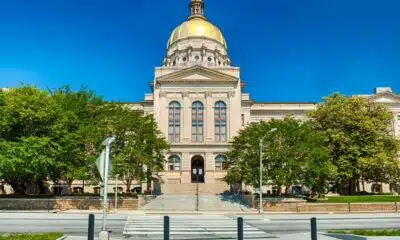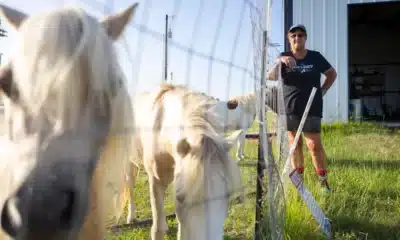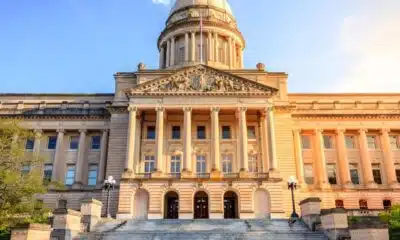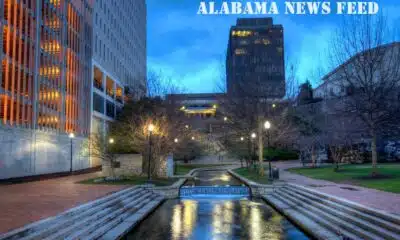News from the South - Alabama News Feed
In Homewood, a fight for the spotted salamander
by Lee Hedgepeth, Inside Climate News, Alabama Reflector
April 13, 2025
This article originally appeared on Inside Climate News, a nonprofit, non-partisan news organization that covers climate, energy and the environment. Sign up for their newsletter here.
HOMEWOOD — Ellen McLaughlin said she wasn’t speaking for herself.
“I speak for the salamanders,” she told those gathered at a community meeting in late March.
McLaughlin, a retired Samford University biology professor, was one of dozens who showed up at the Homewood Senior Center to express their frustration over a proposed “town square” development that will threaten the habitat of spotted salamanders in the Birmingham suburb.
Flanked by oil paintings of wildflower fields and a waterfall, she made her views well known.
“They require a certain habitat, and to destroy that habitat is going to destroy that population of salamanders,” she told those in attendance, including representatives of Landmark Development, the company overseeing the project on behalf of the university. “So it’s imperative that we keep that.”
McLaughlin wasn’t alone in her concerns. Again and again, residents and other stakeholders present at the community meeting hosted by the development company brought up the plight of the amphibian that has, over time, become part of the character of Homewood, home of a salamander festival held annually for two decades.
Bob Dunn, CEO of Landmark Development, said in an interview that he understands residents’ concerns but that he can’t promise that there will be no impact to the spotted salamanders and the vernal pools where they lay their eggs each year.
“Could we encroach on portions of the habitat? As you look at the plan, there are areas where there’s some encroachment,” he said. “But we think the mitigating opportunities will more than compensate for the type of encroachment we’re talking about.”
Residents, biologists and members of the university community interviewed by Inside Climate News largely disagree. Currently proposed plans don’t leave room for changes that would protect the salamanders’ current habitat, they argue, putting at risk the survival of a population that’s called the city home for generations.
A salamander’s tale
The spotted salamander has long been a unique part of Homewood’s history.
Since at least the 1960s, and likely much longer, experts say, the amphibians have spent much of their time burrowing on the slopes of Shades Mountain, making their homes beneath the fallen leaves and limbs of the forest.
Once a year, as temperatures in Alabama begin to climb, the amphibians migrate from the mountain’s slopes across South Lakeshore Drive, a two-lane road, to the springtime, “vernal” pools located in a narrow patch of woods adjacent to existing sports fields that line Shades Creek.
The trek is not always simple. Most often, the salamanders embark on their journey at night, and typically in heavy rains—likely as a way to keep wet and avoid predators.
James Seay Brown Jr., a retired folklorist and natural historian who worked at Samford, wrote about Homewood’s relationship with the spotted salamander in his book, “Distracted by Alabama: Tangled Threads of Natural History, Local History and Folklore.”
When Brown arrived at Samford in 1971, the university’s environmental community was already tracking the salamanders and their annual migration. Brown quickly became obsessed with their yearly trek, and the fixation rubbed off on others over time.
Soon, Brown recruited his wife Michelle to serve as a sort of salamander Paul Revere—tasked with calling a list of interested locals when her husband had confirmed that the amphibians were on the move.
In 2002, Brown awoke to a heavy rain around three in the morning, traveled down to the migration site and confirmed the annual journey had begun. He alerted Michelle, who he said became nervous about calling one person in particular on the list — a Samford executive — so late at night. The executive’s wife answered, surprised by a woman’s voice on the other end of the line, but awkwardly agreed to share the news with her husband. The executive soon showed up for the crossing. So did his wife.
“And here were highly placed administrators of [University of Alabama at Birmingham] and Samford, plus otherwise upstanding businesspeople, professionals, and good family folks, all willing to risk their reputations by such behavior—though I might note some brought children as an excuse,” Brown wrote. “My wife later remarked drily that the ranks of insanity were growing. This may also have been the reaction of Homewood’s mayor at that time, Barry McCulley, when he first heard about it from some police report about flashlights in the woods near the high school at eleven o’clock at night and suspicious answers to straightforward police questions.”
By 2003, the excitement and intrigue over the annual salamander crossing had reached its peak, and city officials in April of that year officially designated a nearly half-mile stretch of South Lakeshore Drive as a salamander crossing—painted crosswalks and street signs included.
By the next year, the city hosted the first Salamander Festival, a tradition that’s continued to this day. In 2024, more than 900 attendees flocked to Homewood for the event, according to organizers.
In 2008, the city of Homewood took another step that aided the salamander—designating around 65 acres of land along South Lakeshore Drive, opposite the breeding pools, as a protected natural area: Homewood Nature Preserve.
Now, though, residents of Homewood fear the worst—that the desire for development will outweigh the need for environmental stewardship of the amphibians’ habitat. That’s why residents like Ellen McLaughlin say they will speak for the salamander.
A Creekside development
March’s community meeting at the Homewood Senior Center was partly a result of the city’s planning commission encouraging Landmark Development to more deeply engage with citizens over their concerns, according to city officials.
The development, called Creekside, is billed by the developer as a “dynamic, walkable, livable town square environment” that will feature everything from “trendy shops to delightful eateries.”
The project is part of Samford University’s “Samford Horizons” initiative, which the university touts as “a visionary master plan to ensure Samford remains among the world’s most respected Christ-centered universities.”
Samford, founded by the Alabama Baptist State Convention in 1841 as Howard College, has increased enrollment for the past 16 years in a row. University officials have said the proposed Creekside development will help to accommodate that growth, providing additional housing, retail options and sport facilities.
At the March meeting, members of the public were vocal about their opposition to the project. No one expressed support for the developer’s proposal.
Of particular concern to residents is a proposed 10-story hotel—which would be the tallest building in the city—and the implications for traffic, stormwater management and environmental stewardship as it relates to the spotted salamander.
Historically, the university has often found itself in tension with city officials and residents over development. Echoes of that tension surfaced in the community meeting.
“Samford wants to do this to us,” Becky Smith, a Homewood resident, said in a deep Southern drawl. “We don’t want you coming down here to tell us what you’re going to do to us.”
The framing of the new development as providing a new “town square” for Homewood belies Samford’s claims that it wants to develop a closer relationship with the city, she argued.
“Samford has said they want to be more a part of Homewood,” Smith said. “This is trying to make Homewood more a part of Samford.”
After those comments, Colin Coyne, Samford’s vice president for finance, business affairs and strategy, spoke up, telling community members that the university’s past friction with the community that surrounds it is not lost on him.
“I acknowledge the fact that we’ve not always been the best neighbors,” Coyne said. “But we have to start somewhere. This is our best attempt.”
Dunn, who spoke on behalf of Landmark at the meeting, said that the developer would do its best to mitigate the impact of the Creekside project on the spotted salamander’s springtime habitat. Landmark would certainly not be able to guarantee, however, that its engineering fixes would solve every problem, he said.
“It’s about really elevating issues that we have to stay focused on to continue to work to find good solutions that balance out all of the issues that go into a development,” he said. “We solve over here for the salamanders, and it creates an issue somewhere else. You’ve just got to find a balance.”
A threat to the salamander
The day after the meeting, Megan Gibbons put on her boots and waded into a place she feels at home, and where the salamanders do, too: the vernal pools just north of South Lakeshore Drive. There, she carefully reached into the water again and again, searching for the salamander egg masses she’s fighting to protect.
It’s here, in the shadow of Shades Mountain, near the shores of Shades Creek, where Gibbons, an assistant professor of biology at the University of Alabama at Birmingham, has done some of her best teaching. It’s here, in the stagnant springtime pools, shaded by the trees overhead, where she’s sparked the passions of students from across the country. And it’s not just for their benefit that she wants these salamanders to survive. It’s for the next generation of salamanders, too.
It doesn’t take Gibbons long to find an egg mass. She smiles as she holds out the jelly-like blob that can contain between 10 and 100 eggs. Through the translucent membranes, you can see the tiny salamanders beginning to take shape— amphibians that will soon hatch and make their first journey over to the slopes of Shades Mountain.
“This one’s pretty far along,” she says of the egg mass, pointing out the various points of interest. “You can see its little body, and you can see its little fluffy gills coming out the side of its head.”
In this environment, Gibbons is doing what she loves best—teaching. It had been the same the evening before, when Gibbons—not then in her wading boots—had stood studiously along one wall of the meeting room, an educational poster about the salamander habitat at her side. One by one, she spoke to residents who approached her, explaining the risks posed by the impending development.
A day later, as she stood holding the egg mass, she weighed again what was at risk. It’s about balance, Dunn had said at the meeting. Balance in favor of what, Gibbons wondered.
“They’re going to make a lot of money from this,” Gibbons said of the developer. “What do we get out of this? What do the salamanders get out of this? I get to see the animal I love destroyed. That’s what I get.”
Soon, Gibbons had carefully replaced the egg mass into the vernal pool and climbed back to the adjacent roadway. A passerby, a retiree named Barbara Koehler, stopped to ask if Gibbons was looking for salamanders. She’d been at the meeting with the developer, too, she said, and didn’t like much of what she heard.
“What do we get out of this? What do the salamanders get out of this? I get to see the animal I love destroyed. That’s what I get.”
– Megan Gibbons, University of Alabama at Birmingham biologist
“I think the guy from Landmark was smooth,” she said. “He was good at glossing over the issue. He knows exactly what he should say to get people to think he’s not going to do exactly what he knows he’s going to do.”
Throughout the meeting, Dunn had emphasized that direct community engagement was not technically a required part of development in Homewood, Koehler recalled. Any construction could move forward simply with the necessary approvals from the Homewood City Council. Engagement would be ideal, Dunn said, but was not a mandate. To Koehler and Gibbons, that felt like a threat—an insinuation that meaningful community engagement could stop at any time if it suited the developer.
Koehler, a self-described birder and naturalist, said she’s opposed to the development.
“It’s just not a good idea,” she said. Her gaze soon pointed to the skyline, darting from tree to tree as birds chirped eagerly in the daylight sun. “This is worth protecting.”
Finding a way forward
What Dunn said about a lack of required input from residents is largely true.
On April 1, Dunn attended a meeting of the planning commission, a body required to recommend either approval or denial of the development plan by the Homewood City Council. Only Dunn—no residents or other stakeholders—was allowed to speak, according to a Homewood recording of the session. The CEO characterized the feedback he’d received from residents as “overwhelmingly positive.”
During the presentation, however, Dunn announced the publication of a report containing potential adjustments to the original development plan based on comments from residents. Ninety-two percent of written comments were about environmental stewardship, according to the developer’s own numbers.
The adjustments in the updated document include potential consideration of a “repositioning” of proposed sports fields that were slated to cover nearly the entire area from Shades Creek to South Lakeshore Drive, though representatives at the March meeting had noted that reducing the fields’ size wouldn’t be feasible given NCAA requirements for field dimensions. Plans for at least two salamander tunnels under South Lakeshore are also outlined in the updated plan—a potential pathway for the amphibians to cross the road without the risk of crossing traffic above ground.
Gibbons said in an interview that she’s not convinced that such slight adjustments will protect a species that has continually been left behind by commercial and residential development, not just in Homewood, but across the state and country. The risk of harming the species outweighs what’s to be gained by more and more development, she said.
Winslow Armstead, a member of the planning commission, pushed Dunn on providing more complete responses to residents’ questions and concerns, particularly when construction on the project could begin as early as this fall.
“I’m still sort of at a loss for the answers on some of those questions,” he told Dunn.
But ultimately, the planning commission recommended approval of the developer’s plan. It is set to be considered by the Homewood City Council in the coming weeks.
Continued engagement with Landmark Development is the best option for influencing what happens beside Shades Creek and Shades Mountain, particularly in today’s political climate, said David Butler, executive director of Cahaba Riverkeeper.
“There’s been a lot of hope that some federal or state agency would come in to help, but all of our environmental protections have been eroded,” he said. “All of the regulatory frameworks we’ve relied on have been broken down, and so we’re really going to have to go through and do a lot of that protection work on our own.”
That work, Butler said, can include direct discussions with developers—emphasizing to those proposing new growth that environmental stewardship must be a firm commitment from the beginning.
When it comes to Landmark and the Homewood project, Butler said he’s optimistic. Landmark reached out to Cahaba Riverkeeper, an environmental nonprofit, even before the first planning meeting, he said.
“I’m encouraged,” Butler said. “We would prefer no development, but that’s not a realistic position to take here. Development is going to happen. But at least we’re at the table. At least we have input.”
YOU MAKE OUR WORK POSSIBLE.
Alabama Reflector is part of States Newsroom, a nonprofit news network supported by grants and a coalition of donors as a 501c(3) public charity. Alabama Reflector maintains editorial independence. Contact Editor Brian Lyman for questions: info@alabamareflector.com.
The post In Homewood, a fight for the spotted salamander appeared first on alabamareflector.com
News from the South - Alabama News Feed
Back-to-School Season in Alabama | Aug. 4, 2025 | News 19 at 6 p.m.
SUMMARY: Alabama schools are starting the new year with a focus on student health, attendance, and readiness. A new law banning phone use in schools is in effect, and educators emphasize the importance of consistent attendance to reduce chronic absenteeism. Greene County Superintendent Corey Jones reports about 900 students returning, with teachers prepared to support diverse needs, including nontraditional and homeless students. The Alabama Department of Public Health advises physicals for all students, especially athletes, to ensure proper growth and mental health. Governor Kay Ivey encourages students to be brave and strive for their best year yet, highlighting their potential to impact Alabama’s future.
Leaders across the state are sharing what students and parents need to know as the new school year kicks off.
News 19 is North Alabama’s News Leader! We are the CBS affiliate in North Alabama and the Tennessee Valley since November 28, 1963.
https://whnt.com/
https://www.facebook.com/whntnews19
https://www.instagram.com/whntnews19/
https://twitter.com/whnt
News from the South - Alabama News Feed
AGs from 15 states sue to block attacks on medically necessary care for transgender youth
by Ben Solis, Alabama Reflector
August 4, 2025
This story is a collaboration between Michigan Advance in collaboration with Wisconsin Examiner.
A coalition of 15 state attorneys general have filed a multistate lawsuit challenging the Trump administration’s effort to restrict access to medically-necessary care for transgender, intersex and nonbinary youth.
The lawsuit challenges recent federal action to deter doctors and medical providers from offering gender affirming care to youth under the age of 19 years old, including states like Michigan where that care is legal and protected.
Joining the suit are the attorneys general of Michigan, New York, California, Massachusetts, Illinois, and Connecticut, Delaware, Hawaii, Maine, Maryland, Nevada, New Jersey, New Mexico, Rhode Island, Wisconsin, and the District of Columbia, as well as Pennsylvania Gov. Josh Shapiro.
GET THE MORNING HEADLINES.
“The Trump administration shouldn’t be interfering with the provision of health care,” said Wisconsin Attorney General Josh Kaul in a statement Friday. “The administration should be respecting individual liberty and equal rights, not shamefully targeting transgender people.”
The attorneys general have asserted that President Donald Trump’s White House is overstepping its authority, using threats of criminal prosecution and federal investigations to pressure health care providers.
“The Trump Administration is attempting to strip away lawful, essential healthcare from vulnerable youth. These orders are illegal and dangerous and have no medical or scientific basis,” said Michigan Attorney General Dana Nessel in a statement. “I will continue to protect families, defend doctors, and stop politicians from putting our kids’ lives at risk.”
Trump in the beginning of his second administration signed an executive order stating that the U.S. would only recognize two sexes, and called for an end to what Trump labeled “gender ideology.” A second order focused on medical restrictions, directing the U.S. Department of Justice to pursue enforcement actions related to that care.
Since then, Nessel’s office said the Department of Justice has issued subpoenas to providers under the guise of criminal law enforcement, but the attorneys general filing the lawsuit Friday argue those efforts lack legal standing and are intended only to intimidate.
“Health care decisions for kids should be made by parents and doctors, not by politicians,” said Erin Knott, executive director of Equality Michigan, a LGBTQ+ advocacy group, in a statement. “The federal government is using funding as a weapon to force providers to abandon their patients and override parents’ rights to make health care decisions for their own children.”
Patricia Wells, a doctor and the medical director of The Corner Health Center in Ypsilanti, Michigan, said in a statement that she and her colleagues are distressed by new punitive changes to funding and regulations, which threaten to dismantle essential care.
“These policies do not protect children; they endanger them,” Wells said. “They undermine trust in the medical system and place affirming providers in an impossible position, forcing hospitals to close clinics and providers to stop offering the very care that helps young people survive and thrive. The loss of these services would not simply be a policy failure; it would be a moral one.”
Wells said the nation must do better.
“These young people deserve our compassion, our evidence-based care, and our unwavering commitment to their well-being,” she said. “I applaud the leadership of the state of Michigan for protecting transgender and gender nonconforming youth, their families, and the caregivers who are saving lives every day.”
Erik Gunn of Wisconsin Examiner contributed to this report.
Michigan Advance is part of States Newsroom, a nonprofit news network supported by grants and a coalition of donors as a 501c(3) public charity. Michigan Advance maintains editorial independence. Contact Editor Jon King for questions: info@michiganadvance.com.
Wisconsin Examiner is part of States Newsroom, a nonprofit news network supported by grants and a coalition of donors as a 501c(3) public charity. Wisconsin Examiner maintains editorial independence. Contact Editor Ruth Conniff for questions: info@wisconsinexaminer.com.
Independent Journalism for All
As a nonprofit newsroom, our articles are free for everyone to access. Readers like you make that possible. Can you help sustain our watchdog reporting today?
Alabama Reflector is part of States Newsroom, a nonprofit news network supported by grants and a coalition of donors as a 501c(3) public charity. Alabama Reflector maintains editorial independence. Contact Editor Brian Lyman for questions: info@alabamareflector.com.
The post AGs from 15 states sue to block attacks on medically necessary care for transgender youth appeared first on alabamareflector.com
Note: The following A.I. based commentary is not part of the original article, reproduced above, but is offered in the hopes that it will promote greater media literacy and critical thinking, by making any potential bias more visible to the reader –Staff Editor.
Political Bias Rating: Left-Leaning
This article clearly advocates for transgender rights and criticizes the Trump administration’s policies restricting gender-affirming care for youth. The language used is sympathetic toward transgender individuals and emphasizes medical and scientific consensus supporting such care. It highlights legal actions taken by Democratic attorneys general and frames the federal government’s enforcement efforts as overreach and intimidation. While the piece reports facts about the lawsuit and quotes officials and advocates, its framing and selection of sources indicate a perspective aligned with progressive values on LGBTQ+ rights and healthcare access.
News from the South - Alabama News Feed
Flood Watch for Alabama: Storms linger overnight, with cooler weather in the forecast
SUMMARY: A flood watch remains in effect in Alabama, especially east of the I-65 corridor, including counties like Blount, Jefferson, Shelby, and others, until 7 a.m. Sunday due to lingering storms and heavy rain. Flash flood warnings and advisories persist in several central and northeastern areas, with some locations receiving over two inches of rain. Drivers are urged to “turn around, don’t drown” and avoid roadways. Cooler, drier air and a cold front are expected to bring showers and thunderstorms early Sunday, followed by cooler and cloudier conditions into the workweek with highs near 80°F, marking a significant weather shift.
Flood Watch for Alabama: Storms linger overnight, with cooler weather in the forecast
Subscribe to WVTM on YouTube now for more: https://bit.ly/2jvAaUD
Get more Birmingham news: http://www.wvtm13.com
Like us: https://www.facebook.com/WVTM13/
Follow us: https://twitter.com/WVTM13
Instagram: https://www.instagram.com/wvtm13/
-
News from the South - Texas News Feed4 days ago
Rural Texas uses THC for health and economy
-
News from the South - Texas News Feed6 days ago
Yelp names ‘Top 100 Sandwich Shops’ in the US, several Texas locations make the cut
-
News from the South - Kentucky News Feed6 days ago
Harrison County Doctor Sentenced for Unlawful Distribution of Controlled Substances
-
News from the South - Missouri News Feed7 days ago
Co-founder of whites-only group speaks on previous homestead stabbing
-
News from the South - Texas News Feed6 days ago
Released messages show Kerrville officials’ flood response
-
News from the South - Louisiana News Feed6 days ago
Residents along Vermilion River want cops to help prevent land loss
-
News from the South - Alabama News Feed5 days ago
Decision to unfreeze migrant education money comes too late for some kids
-
News from the South - West Virginia News Feed6 days ago
‘Good government’ group urges blue states to back away from a redistricting arms race











































